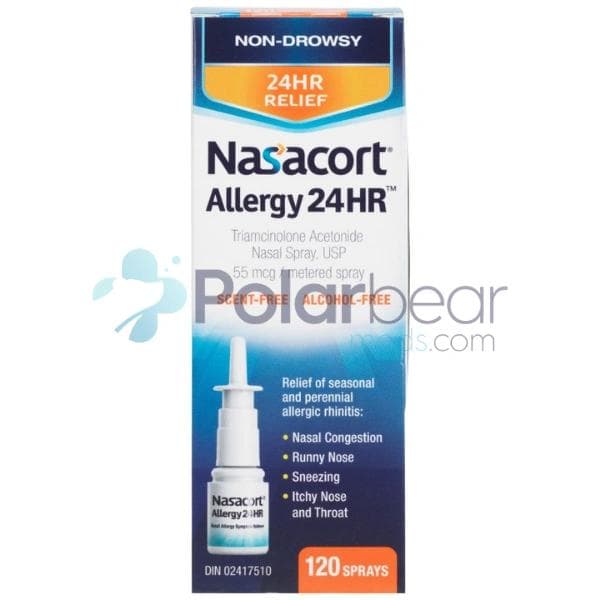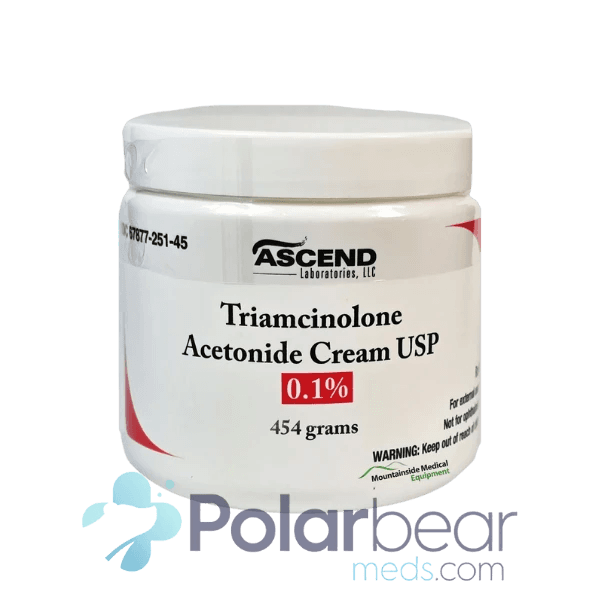
Triamcinolone A…


We offer competitive pricing on all our medications. Find a lower price? We'll match it from any verified Canadian online pharmacy! Know More

We offer competitive pricing on all our medications. Find a lower price? We'll match it from any verified Canadian online pharmacy! Know More
Ordering your medication online is simple and convenient.
Select the prescribed dosage and quantity, then proceed to checkout.
Sign in or create a new account.
Upload your prescription.
Complete your purchase by processing the payment.
Select the prescribed dosage and quantity, then proceed to checkout.
Sign in or create a new account.
Upload your prescription.
Complete your purchase by processing the payment.
Shipping takes approximately 3-5 business days.
Read what our customers have to say about their shopping experience.
Triamcinolone Acetonide is an FDA-approved medication that is available in various topical forms (creams, ointments, lotions), dental paste, nasal spray, and injectable forms to control inflammation & calm your overactive immune systems. This synthetic corticosteroid medication is used to treat autoimmune disorders like ulcerative colitis, allergies, psoriasis, arthritis, eczema, and many other serious conditions. It comes in various strengths according to its form, including injections in 5 mg, 10 mg, 20 mg, 40 mg/mL, cream/ointment in 0.025%, 0.1%, 0.5% formulations, 0.1% dental paste formulation and 55 micrograms (mcg) as a nasal spray. So, if you buy Triamcinolone Acetonide online from the best Canadian Pharmacy, you require the prescription from your doctor first.
Triamcinolone Acetonide, an FDA-approved medication, is accessible in diverse forms, including creams, ointments, lotions, dental paste, nasal spray, and injections. Its primary purpose is to manage inflammation and regulate hyperactive immune responses, effectively addressing autoimmune disorders like ulcerative colitis, allergies, psoriasis, arthritis, and eczema. For adult dosages, Triamcinolone Acetonide comes in injections ranging from 5 mg to 40 mg/mL, while creams, ointments, and lotions are available in formulations of 0.025%, 0.1%, and 0.5%. Dental paste comes in a 0.1% formulation, and the nasal spray is dosed at 55 micrograms (mcg).
Pediatric doses are the same as those of adults, with injections starting at 40 mg for various conditions. There are several instructions for topical use that involve applying the medication 2-4 times daily for dermatitis, eczema, and psoriasis. Dental paste is recommended 2-3 times daily, while injections are administered as a one-time dose or starting at 32 mg for osteoarthritis. The medication’s mechanism involves inhibiting inflammatory substance release and mitigating symptoms like swelling and itching.
However, potential side effects include mood changes, weight gain, and higher blood sugar levels, requiring careful monitoring. Like other medications, it also comes with important precautions that highlight the risk of adrenal suppression, high blood glucose, and skin infections with prolonged use. Additionally, it can be stored at specific temperature ranges for different formulations, emphasizing proper disposal of expired products. It has many alternative options, such as Stelara, Skyrizi, Olux, Clobex, Dermovate, Impoyz, Temovate, Otrexup, and more.
This medication comes in various forms and strengths as follows:
Injections: 5 mg, 10 mg, 20 mg, and 40 mg/mL,
Cream/Ointment/Lotion: 0.025%, 0.1%, and 0.5% formulations
Dental Paste Formulation: 0.1%
Nasal Spray: 55 micrograms (mcg)
Adult Dose
Dermatitis
Eczema
Psoriasis
Osteoarthritis
Eye Inflammation
Arthritis
Lesion
Dental Paste: 2 to 3 times daily after having meals.
Pediatric Dose
Dermatitis
Eczema
Psoriasis
Lesion
For Cream, Ointment, and Lotion: When you use Triamcinolone Acetonide cream, you should follow the instructions below:
For Nasal Spray: If you want to use Triamcinolone Acetonide nasal spray, you can follow these guidelines:
For Dental Paste: Are you looking to use Triamcinolone Acetonide dental paste? Here are the instructions for its safe usage:
For Injections: Injections are generally administered by a trained healthcare professional.
[Note: Your doctor will decide the right amount for you based on your condition, following guidelines and studies on the drug. They’ll adjust it as needed over time.]
Triamcinolone Acetonide works by inhibiting the release of inflammatory substances in the body, which helps to reduce inflammation, redness, swelling, & itching associated with various conditions. As a corticosteroid, it has anti-inflammatory, antipruritic (anti-itch), and vasoconstrictive (narrowing of blood vessels) effects. By modulating the immune response, it suppresses the activity of immune cells responsible for inflammation, providing relief from symptoms.
Common Side Effects of Triamcinolone Acetonide: When you use Triamcinolone Acetonide cream or other forms to control inflammation conditions, you should know the common side effects associated with this medication, such as:
Serious Side Effects of Triamcinolone Acetonide: When you use Triamcinolone Acetonide cream 0.1, nasal spray, or other forms, it may cause the following serious side effects:
[Note: Remember, this list may not cover all possible side effects. Always consult with your healthcare provider, pharmacist, or doctor for medical advice about side effects.]
When you use Triamcinolone Acetonide cream for psoriasis and other autoimmune disorders, you need to consider the following warnings:
Adrenal Suppression: In rare instances, the application of topical triamcinolone acetonide may result in the suppression of adrenal glands, which are responsible for producing natural corticosteroids in the body. The likelihood of adrenal suppression is higher when using more corticosteroids compared to less potent ones. Additionally, prolonged use, excessive amounts, application over large skin areas, and the use of occlusive dressings can increase the risk of this adverse effect, as they enhance systemic absorption and produce systemic effects. Children, especially, face an increased risk, with studies revealing that topical corticosteroids, similar to systemic ones, can hinder growth and delay weight gain.
High Blood Glucose: Prolonged or extensive use of topical triamcinolone acetonide can lead to elevated blood sugar levels, akin to the effects of systemically administered corticosteroids. Quickly inform your doctor if symptoms such as sleepiness, unusual thirst or hunger, flushing, urinary frequency, fast breathing, fruity-smelling breath, or confusion develop. For individuals with diabetes, increased monitoring of blood sugar levels may be recommended.
Skin and Mouth Infections: Using Triamcinolone Acetonide ointment for more than 7 days increases the risk of new or worsening dermatological infections. Avoid use if a skin infection is present, as it may exacerbate the condition. Notify your healthcare provider if signs of infection, such as pain, redness, swelling, or pus, emerge. Additionally, report if original symptoms persist or worsen after 7 days of triamcinolone acetonide use.
Skin Reactions: Prolonged use of Triamcinolone Acetonide Cream 0.1 can lead to various skin issues, including thinning skin, stretch marks, spider veins, changes in skin color, rash, itching, burning, irritation, dryness, and inflammation of hair follicles. To minimize the risk of severe reactions, healthcare providers aim to prescribe the least potent steroid that effectively treats symptoms. Promptly inform your doctor of any new or worsening skin reactions.
Here are the following precautions you need to consider when you use Triamcinolone Acetonide ointment or other forms:
Cardio-Renal: Patients with congestive heart failure, hypertension, or renal insufficiency should exercise caution when using corticosteroids, as they may lead to sodium retention, causing edema and potassium loss.
Endocrine: To minimize drug-induced secondary adrenocortical insufficiency, gradual dosage reduction is recommended. In situations of stress within months after therapy discontinuation, hormone therapy should be reinstated. Concurrent administration of salt and/or a mineralocorticoid is advisable due to potential impairment of mineralocorticoid secretion.
Gastrointestinal: Steroids should be used cautiously in patients with active or diverticulitis, latent peptic ulcers, fresh intestinal anastomosis, and nonspecific ulcerative colitis, as they may increase the risk of perforation. Signs of peritoneal irritation following gastrointestinal perforation can be minimal, especially in patients on corticosteroids.
Musculoskeletal: Corticosteroids can inhibit bone growth in pediatric patients and lead to osteoporosis in individuals of any age. Special consideration is required for patients at an increased risk of osteoporosis, like postmenopausal women, before initiating corticosteroid therapy.
Neuro-Psychiatric: While corticosteroids may speed up the resolution of acute exacerbations in multiple sclerosis, their ultimate impact on the disease’s outcome or natural history is unclear. High doses are often necessary for a significant effect. Acute myopathy may occur with high corticosteroid doses, especially in patients with neuromuscular transmission disorders or those on neuromuscular blocking drugs. Psychiatric derangements, ranging from euphoria to severe depression or psychotic manifestations, may also occur.
Ophthalmic: In some individuals, intraocular pressure may increase during steroid therapy lasting more than 6 weeks. Regular monitoring is advisable in such cases.
[Note: If you have missed a dose of your medication and are unsure about when to take the next one, immediately consult your doctor or pharmacist.]
If someone takes too much medicine and is really sick, like passing out or having trouble breathing, call 911 immediately. Otherwise, reach out to a poison control center right away. They can help in case of accidental overdose. Remember, it’s important to act fast to get the right help.
[Note: If you consumed more than the recommended dose, get medical help right away or call the Poison Help line at 1-800-222-1222.]
When you consider using Triamcinolone Acetonide cream 0.1, ointment, dental paste, or injections, you can follow the instructions mentioned below:
[Note: Discuss with your healthcare professional about the proper disposal of any unused medicine and any questions you may have regarding its storage.]
Triamcinolone acetonide, a corticosteroid known for its efficacy in reducing inflammation, can interact with a range of medications. Here, we explore how it interacts with different substances:
[Note: This isn’t a complete list, and there could be other drugs that interact with Triamcinolone Acetonide. Make sure to tell your doctor about any prescription, over-the-counter medicines, and herbal products you’re taking.]
There are several alternatives available for this medication. Some of them are listed below:
[Note: Your doctor will choose what’s best for you. Don’t use any of these alternative medications without consulting your healthcare provider. Taking them by yourself may cause serious side effects].
The cost of Triamcinolone Acetonide can change depending on your insurance and where you buy it. Many times, insurance doesn’t cover all the costs, so you might have to pay a lot out of pocket. To save money, some people buy it from Polar Bear Meds in Canada at a lower price. You can use the coupon code “WELCOMEPB10″ for a 10% discount on your first purchase. Always talk to your doctor or pharmacist about ways to save money, and make sure you’re buying from a reliable source.
AtPolarBearMeds.com, we assure you the most affordable price to buy Triamcinolone Acetonide from Canada. Rest easy knowing that your order will be dispatched from a reputable Licensed Canada Pharmacy Online, adhering to the highest standards of quality and authenticity. Our discounted medications are shipped directly from Canada to your doorstep, ensuring a swift and secure delivery experience. To conveniently access Triamcinolone Acetonide at a substantial cost, call us at 1-888-779-2193 toll-free.
The content provided on the Polar Bear Meds website serves to increase knowledge about healthcare products and medical conditions and is strictly for informational purposes. It should not replace professional medical advice. We urge you to consult with a qualified healthcare professional prior to utilizing any prescription or over-the-counter medication. Our platform grants access to an extensive array of products, sourced internationally, including Canada. We collaborates with a licensed pharmacy partner in Canada and trusted dispensing pharmacies globally. All affiliated fulfillment centers are accredited by the regulatory authorities of their respective countries.

Dr. Jackson Miller is a board-certified medicine physician & hospitalist. He is a healthcare professional with a strong background in patient care. With years of experience and a patient-first approach, he believes the foundation of good health is a patient who feels informed and empowered. He contributes to medical content review, drawing on his background in clinical practice and patient education. He focuses on presenting health information in a clear, accurate, and accessible way to help readers make informed decisions. His work emphasizes clarity, evidence-based guidance, and understandable explanations of medical topics.

We offer competitive pricing on all our medications. We'll match if you find a lower price on an identical product at a verified Canadian online pharmacy!
Need help? Call our friendly support team at 1-888-779-2193 or fill out the Contact Form